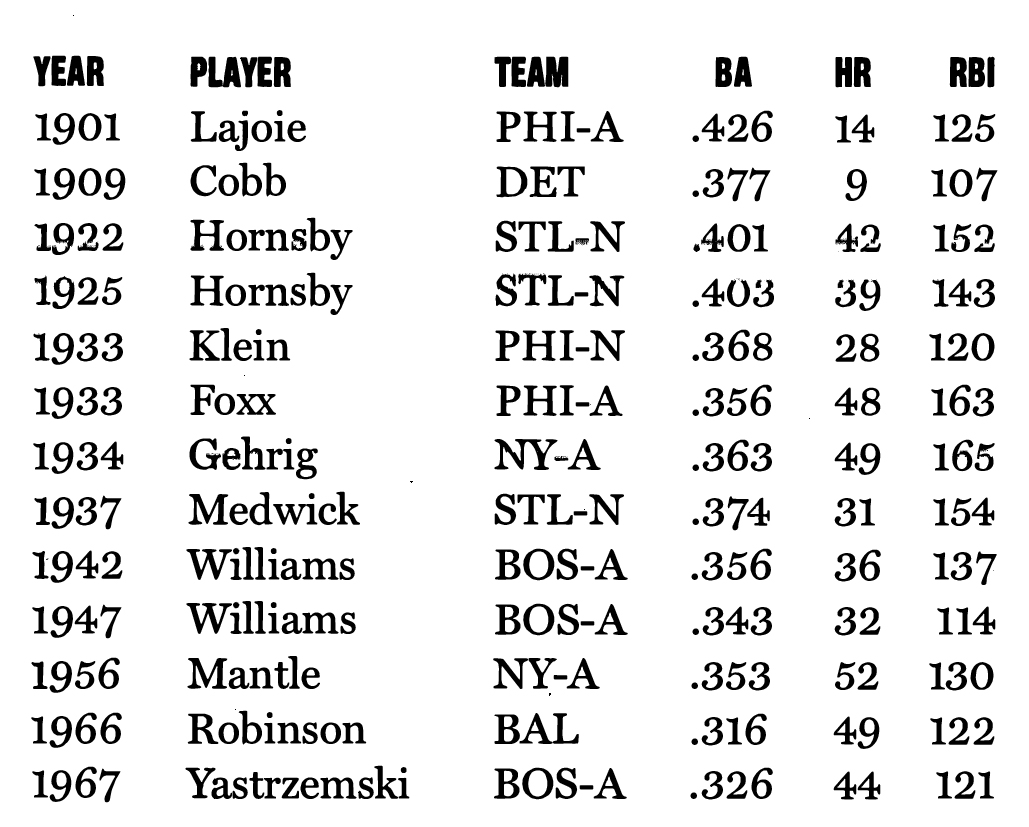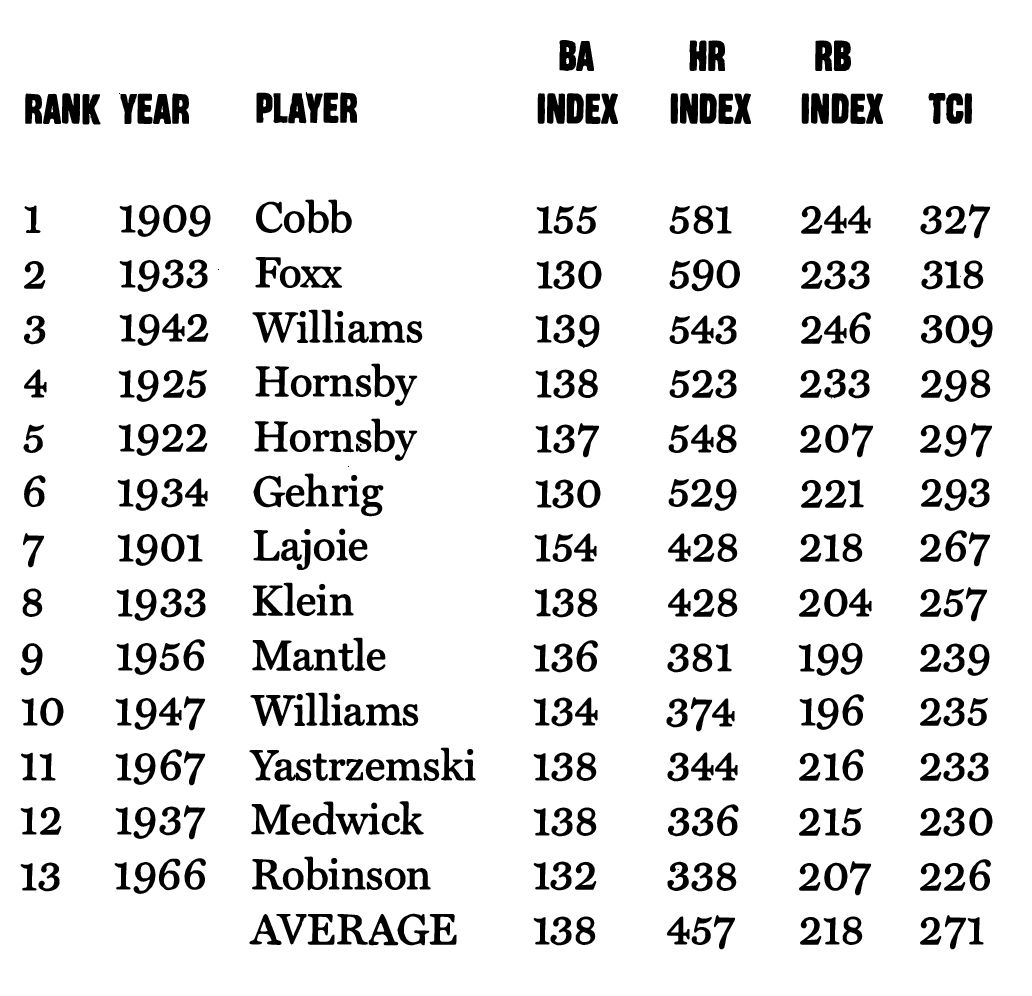The Most Dominant Triple Crown Winner
This article was written by Vince Gennaro
This article was published in 2002 Baseball Research Journal
Baseball’s Triple Crown is a heroic achievement reserved only for the sport’s elite. It has been accomplished only thirteen times since 1900, by eleven different stars. Only Rogers Hornsby and Ted Williams were able to repeat the feat of winning the league’s batting title, home run crown and RBI title in the same season.The achievement is virtually synonymous with baseball immortality, as every twentieth century Triple Crown winner is a Hall of Farner.
In today’s era of specialization, where players tend to earn the classifications of ”home run hitters”, or “RBI guys” or ”high average hitters”, fewer batters seem to possess the total package of the complete hitter necessary to win a Triple Crown.The feat occurred at least once a decade in each of the first seven decades of the 20th century. That counts Heinie Zimmerman, who for years was listed as a Triple Crown winner in 1912 — the lone winner that decade. But research in the 1990s gave the RBI title to Honus Wagner. There has been no Triple Crown winner since 1967, when Carl Yastrzemski narrowly won.
The following is the list of the post-1900 Triple Crowns:
There are several noteworthy aspects of the thirteen Triple Crowns. Four of the thirteen occurred within a five-year span, from 1933 to 1937, with “matching” achievements in the same city in the same year … the Phillies’ Chuck Klein and the A’s Jimmie Foxx. The Cardinals and Red Sox lay claim to the most Triple Crowns with three each, aided by double winners Hornsby and Williams. Nine of the accomplishments were in the American League, with no National League winners in the last sixty-five years.The stats reveal the lowest batting average of a winner was .316, while single digit home runs made the list once.
Is there a meaningful way to differentiate among Triple Crown winners? Does any one Triple Crown season standout as a more dramatic accomplishment? From a statistical perspective, how would the Triple Crowns rank against one another? One plausible methodology to compare Triple Crown performances is to evaluate the winners’ statistics relative to the remainder of the league, for the same season. The effect of this analysis would be to “normalize” the performance statistics, eliminating the variability of batting statistics over different eras of modern baseball. This method creates indices of the individual winner’s performance versus the average performance of all hitters in the same league, for each of the three relevant stats, batting average, home runs and runs-batted-in. One can then create a simple average of the three indices to create an overall Triple Crown Index (TCI).
THE TRIPLE CROWN INDEX (TCI) FORMULA
TCI = (BA Index + HR Index + RBI Index) / 3
where
- BA Index = (Player’s batting average (League batting average)) x 100
- HR Index = (Player’s home runs per at bat (League home runs per at bat)) x 100
- RBI Index = (Player’s RBI per at bat / (League RBI per at bat)) x 100
The TCIs could then be compared for each Triple Crown performance, effectively ranking the player’s performance versus his peers. The results are:
By this methodology, Ty Cobb’s 1909 season emerges as the most dominant Triple Crown win. His most impressive statistic was his .377 batting average, wining the title by 31 percentage points over the A’s Eddie Collins, in a year when the AL batted only .244, and only seven players batted over .300. Cobb’s batting average index relative to the league was 155, a high for all Triple Crown winners. Also, Cobb’s nine homers represented over 8% of the total home runs hit in the entire AL in 1909. He also led the league in total bases, hits, runs scored, slugging average and stolen bases.
Ironically, Cobb hit for a higher average in seven of the next 10 seasons. In possibly his best season, 1911, Cobb batted .420 with 8 home runs and 144 RBIs. In that glorious season, Cobb won the batting and RBI titles, but trailed Philadelphia’s Frank Baker by three home runs, and was denied a second Triple Crown. Ranking second to Cobb’s 1909 win is the 1933 season of Jimmie Foxx. While Foxx was not as dominant in the batting average category, winning the title by 20 percentage points and a 130 index to the AL batting average, he dominated in the home run category. His 48 HRs topped Babe Ruth’s 34 and indexed at 590 to the AL (on a per at bat basis), as only four American Leaguers hit over 20 home runs. Further testimony to Foxx’ homer prowess in ’33 occurred cross-town as Chuck Klein was duplicating the feat with his own Triple Crown season in the NL for the Phillies.
Klein won the National League HR crown with a modest 28 four-baggers. Third place in the Triple Crown derby was Ted Williams’ first win in 1942, aided by his RBI dominance. Williams’ 137 RBI topped DiMaggio’s second best 114 in a year when only 5 players drove in 100 or more runs. It is also noteworthy that both of Hornsby’s Triple Crowns were statistically comparable to one another, ranking 4th and 5th all-time. Five Triple Crown winners also won the major league Triple Crown, meaning their batting average, HR and RBI totals were tops in both leagues … Cobb, Hornsby (1925), Gehrig, Williams (1942) and Mantle.
While there may not be a ”weak” Triple Crown, statistically speaking, the least impressive Triple Crown accomplishment was Frank Robinson’s 1966 season with the Orioles, his first in the American League. In fact, Robinson’s .316 batting average was lower than that of five National Leaguers. Also of note is the five lowest ranked Triple Crown victories include the most recent four, Williams’ 1947, Mantle’s 1956, Robinson’s 1966 and Yaz’s 1967. At the top of the list in the “near miss” category is Babe Ruth’s legendary 1921 season. Ruth’s .378 bating average trailed two Tigers — Heilmann (.394) and Cobb (.389) — preventing him from winning the Triple Crown. However, his home run dominance (59 vs. the “runner up” at 24) and RBI dominance (171 vs. the “runner up” at 139), makes it one of the most dominant non-Triple Crown seasons.
Anyone who achieves a Triple Crown in the 21st century will certainly be heralded, regardless of his margin of victory in any one statistical category. Nonetheless, as we strive to gain perspective on historical accomplishments over more than a century’s time, it is interesting and useful to attempt to measure “degrees of greatness.”
VINCE GENNARO is a business executive residing in Purchase, New York. This is his second article to appear in The Baseball Research Journal.




